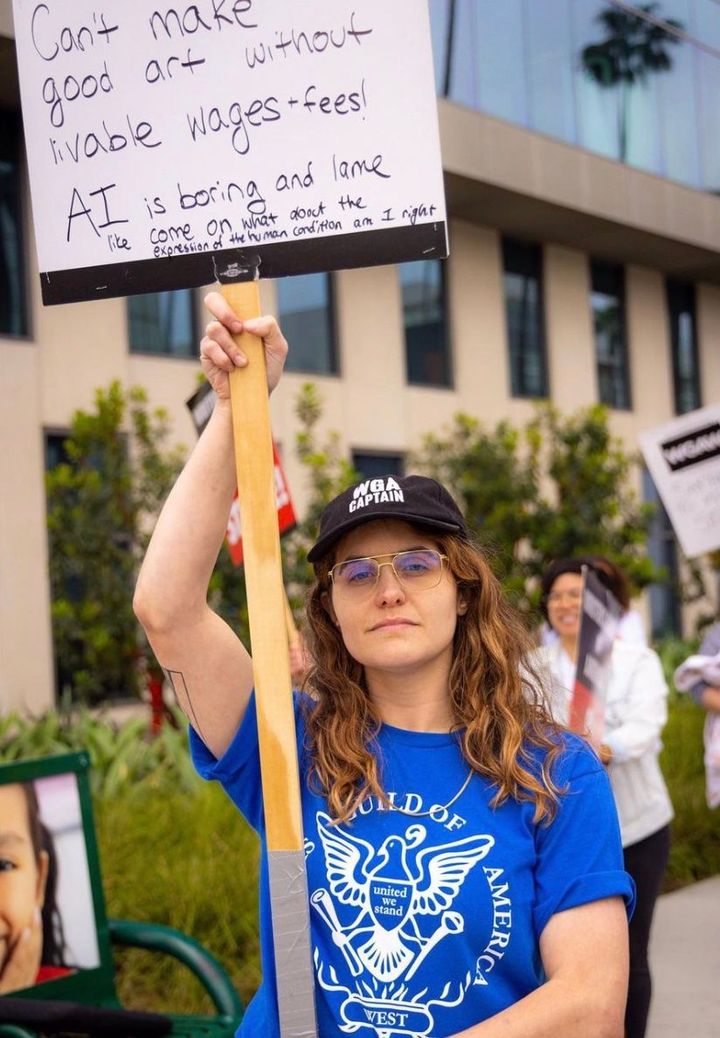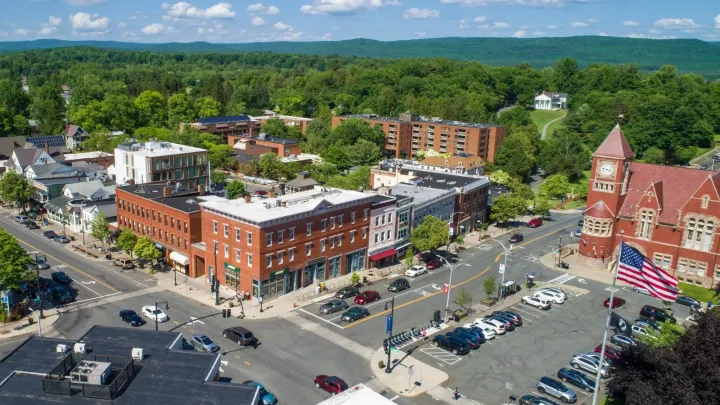A Potential Partnership with Amherst Public Schools
As the Amherst-Pelham Regional School District faces up to $1.7 million in cuts to services, the town has expressed interest in a long-term financial agreement with the college. Staff writer Neil Kapur ’25 explores how the college could be a better neighbor to the public schools.

On March 12, as I was walking from the town towards the college, I ran into a protest outside town hall organized by the Amherst Pelham Education Association (APEA), the local teacher’s union. They were voicing their opposition to $1.7 million in cuts in a proposed budget that the regional school committee would vote on later that evening. I overheard a teacher voice frustration into a megaphone about the recurring cuts the district had been facing. Curious and eager to learn more, I decided to put my journalism cap on and interview the marchers to better understand the cuts.
Given my lack of prior knowledge on the issue, I was surprised when, as I was conducting interviews, the protestors started marching in the direction of the college, assembling outside Converse Hall. The protesters I interviewed assumed I would be aware of the fact that the college did not pay property taxes on most of its property and that PILOT agreements could be a potential remedy. However, this was all news to me and likely to many Amherst students. I ended up writing an article that evening that captured the sentiments felt that day — the college should use its endowment to provide greater financial support to the public schools.
On March 26, two weeks after the protest, the Regional School Committee voted to create a subcommittee “to discuss long and short-term partnerships and financial contributions from Amherst College to the regional schools.”
Deb Leonard ’89, a school committee member and Amherst alum, said that while this subcommittee cannot directly negotiate with the college (something that only the superintendent and town manager can do), it hopes to build institutional knowledge about historical relations with the college and what future partnerships may look like. As the district will soon appoint a new superintendent, this knowledge could help inform future negotiations.
Moreover, various community groups, including high school students, educators, and parents, have met with the college to discuss how the college can support the schools in the long run.
While local media sources such as AmherstIndy and the Daily Hampshire Gazette have reported on the school committee’s plans to explore a partnership with the college, I was curious to see what a long-term agreement might look like. Therefore, in this article, I hope to bring everyone reading up to speed on the recent budget cuts, along with what a partnership could entail.
I interviewed President Michael Elliott and Director of Community Engagement Sarah Barr, as well as a few community members who have been in dialogue with the college. Before shining light on recent conversations, it is worth recapping why the budget cuts happened in the first place.
Why is the district facing cuts?
The recent financial troubles are part of a larger structural problem that has been exacerbated by current inflationary pressures. The “costs for running the district,” including salaries, health insurance benefits, food, utility, and transportation, “have been rising much faster than the funding that’s available,” according to Allison McDonald, a former chair of the Regional School Committee and managing editor of the Amherst Current, a local news organization. This deficit is not unique to the district but is being faced by other rural districts as well. Consequently, the district has been unable to maintain the same services from year to year, also known as level services.
There are many forces that caused this imbalance. For example, Proposition 2 ½, a state statute, constrains the total revenue the town can collect annually from property taxes: 2.5 percent more than the prior year, which is not ideal during periods of high inflation. This does not mean a 2.5 percent increase in the tax rate, which is capped at 2.5 percent under the statute, but rather a 2.5 percent growth in total revenue resulting from increased property values. The town could ask voters for a one-year boost in tax revenue above the state-imposed limit through an override. However, residents from all four towns that comprise the district — Amherst, Pelham, Leverett, and Shutesbury — would have to approve it.
Another important source of revenue, state aid, has also failed to keep up with rising costs. After the passage of the 2019 Student Opportunity Act, which implemented a funding formula that prioritizes low-income schools, the district has seen smaller annual increases in state aid. As McDonald explains, “relative to other communities … Amherst is considered affluent,” and has historically spent a large portion of its budget on education. Therefore, while overall state spending on education has increased, the town benefits less than other districts with greater financial need.
Moreover, the state government has failed to deliver on certain promises. For example, the district is owed reimbursement for transportation costs. Historically, the four towns that comprise the regional district maintained separate districts, and still do for students up to sixth grade. However, in 1955, students from seventh to twelfth grade started attending the consolidated district. Therefore, the cuts described in this article refer specifically to the middle and high schools. Nevertheless, the Amherst elementary schools, which undergo a separate funding process, were almost subject to cuts that the town was able to avoid for this upcoming fiscal year.
Regional school districts face higher transportation costs because they cover a larger geographic area. Some students may spend over an hour riding school buses as a result. Theoretically, such districts are promised reimbursement from the state to help offset these increased costs. The state wants to incentivize regionalization as they are often more cost-efficient. However, in practice, the districts aren’t always fully compensated — sometimes receiving as little as half the amount needed to cover transportation expenses.
Finally, the district has faced declining enrollment, a trend common in rural Massachusetts. In 2010, the district served 1,574 students compared to the 1,210 students currently enrolled, a decrease of 23 percent. Less pupils means less state aid. However, in practice, it is difficult for districts to adjust to this loss in revenue as education is not a divisible good. It is not as if schools can close a fraction of a classroom. Nevertheless, in the long run, some argue that as enrollment continues to decline, the district needs to become more efficient and develop a more sustainable model to avoid future budget shortfalls.
Overall, this is a simplified explanation of a more complex problem. There are many other factors that are cited in conversations about the district’s budget, including the state’s charter school funding formula. McDonald has written in detail about the school’s financial situation in the Amherst Current for those interested in learning more.
In the short run, the money allocated to the district by the four towns for the upcoming fiscal year remains $1.7 million below the amount needed to maintain level services. Following the March 12 protests, the Regional School Committee voted to restore $1 million of those cuts back into the budget. In order to attain that funding, they plan to ask the town governments for a one-time gift. Whether this revised budget is feasible will be decided in the coming weeks as the four towns deliberate over their ability to finance the requested funds.
While there have been no formal requests for the college to cover any of the current deficit through a short-term gift, there is great interest in a long-term financial contribution.
Why is the town asking for the college to contribute more?
The primary reason town residents want the college to contribute more to public schools stems from its exemption from paying local property taxes as an educational institution under Massachusetts state law. Elliott clarified that the college does pay some property taxes, a little under $700,000 annually on property that is “deemed not to be part of the educational purposes of the college,” such as faculty housing.
Nevertheless, most of its property, including residence halls and academic buildings, is not subject to property taxes, the main source of revenue for the public schools. Armed with an endowment worth over $3 billion, many believe the college can and should provide more financial support to the schools.
That isn’t to say that the college provides little value to the town. McDonald asserts that “there is a lot of the value the college contributes to the community,” including the residents it attracts. Nevertheless, she adds that as a result of the tax exemptions granted to the college and the University of Massachusetts, Amherst, “looking purely at the tax bill, there’s a huge opportunity cost for the town [as the revenue] could be supporting our public schools.”
To clarify, McDonald does not believe the college should be taxed the millions of dollars it would otherwise owe without the state-imposed exemption. However, she states that “a long-term strategic agreement [that spans] multiple years would be hugely beneficial.” As an example, she referenced the University of Massachusetts’ recent strategic agreement with the town, which includes $5.5 million in contributions over five years, with $1 million designated for the schools.
Advocates for greater college support also point out that peer institutions have entered into financial agreements with their municipal governments, known as payment in lieu of taxes (PILOT). For example, the University of Pennsylvania will contribute $100 million towards school infrastructure improvements in Philadelphia, including the removal of asbestos and mold. Additionally, Williams College pledged $5 million to assist with the construction of a new fire station in Williamstown.
Why did the college contribute $1 million to the Jones Library?
The college has signaled its interest in supporting the community financially with a recent $1 million dollar gift towards the Jones Library renovation. I wondered why the college gave such a generous amount to the library, given the public schools’ demonstrated need.
“[The library] had a very clear plan,” President Elliott told me. He added that the library’s project underwent a rigorous review process for a separate grant, funded by the National Endowment for the Humanities, and therefore this external validation gave the college “a high degree of confidence that their plan is going to be successful,” allowing the college to make a difference in the community.
Moreover, Elliott noted that the public schools have not formally requested any short-term gifts from the college. He explained, “it was never as though we were presented with a plan for the schools and a plan for the library and chose one over the other.” Additionally, he stated that the college would be open to “discussing other clear plans and proposals.”
What could a long-term agreement look like between the college and the public schools?
It is still unclear what a long-term partnership between the college and the public schools might entail. In fact, President Elliott noted that the college has been in negotiations with the town for the past two years over additional funding, but they have yet to reach an agreement.
Moreover, Elliott and Barr are working to better understand the districts’ needs. Elliott stated that while the administration “[has] several ideas,” they have also “been trying to cultivate what the district actually needs from us.” “I think it would be a little hubristic on our side to say here’s what those schools need,” he added. Barr emphasized that “good community engagement is done in relationship, and it’s never going to be about Amherst College telling the community what to do.”
However, a group of high school students have proposed a few possible contributions. The Sunrise Movement is a national youth movement that advocates for climate and economic justice. Sunrise Amherst, the local “hub,” met with the college on April 2 to discuss their ideas for a long-term agreement, including a $1 million one-time gift to install solar panels on the roof of the high school and an annual $900,000 contribution to the district.
Among the students who met with college officials include Amherst-Pelham Regional High School students Julian Hynes and Amrita Rutter, co-hub leaders, and Jesse Warren, the chapter’s outreach director. Overall, they had positive things to say about the meeting. They felt that the college shared similar values and the meeting served as a way to exchange information. On the one hand, the college could better understand the districts’ needs. On the other hand, the group learned more about the intricacies of the endowment, including the regulations the college must abide by when withdrawing from it. Armed with greater information, they plan to finetune their proposals and suggest ways the college could finance their ideas under the constraints of the endowment. They plan to meet with Elliott on May 10.
The college has also met with the APEA and a group of parents to better understand their perspectives. However, the school committee has yet to set a meeting between the college and members of the newly formed subcommittee.
Leonard and McDonald also emphasized that there is a lot the college already contributes to the district. In fact, Leonard hoped that the subcommittee would re-frame existing narratives so as to not approach the partnership as an obligation, but rather with gratitude for what the college has already done and hope to build on existing relationships.
For example, the college offers high school students the opportunity to take classes at the college at no cost, with about 400 students taking advantage of this program over the past 10 years, according to Elliott. It also funds a position at the district’s family center through an annual contribution of $75,000. Moreover, students regularly attend field trips at the Book and Plow Farm as well as the Mead and Beneski museums. Finally, the college encourages community engagement, whether that be through extracurriculars, such as the music tutors program in which college students assist with music instruction or coursework.
This type of partnership work “has depended on faculty and student interest,” said Barr. She actively works in collaboration with the schools to identify these opportunities for engagement and find the funding to support such initiatives. Elliott added, “we’ve been working over this last year to … incentivize and advertise to faculty that we would love to support more faculty doing [these] kinds of projects.”
Barr has also been working to find “more creative ways” the college can partner with the community. One example she commonly cites is that the college used its expertise to help the Amherst Survival Center develop a custodial plan when it moved into a new facility. The center lacked this expertise so the college’s facilities department was able to facilitate the process. Barr hopes that through dialogue with the district, the college’s expertise can find ways to collaborate with the town’s expertise to assist with identified needs.
McDonald affirmed that these “creative solutions” could play an important role. For example, the college could assist with state-level advocacy work, including calling for reforms in the charter school funding formula. She asserted that the college can “lend its prestige, reputation, and influence within the state to support communities … not just Amherst … but also other rural, Western Massachusetts communities.”
Finally, Barr emphasized that the college is always looking to deepen engagement with the town in four priority areas: economic development, public education, sustainability, and intentional inclusion. “In terms of financial support for the schools, the best thing we can do is generate economic activity,” Elliott asserted, as that would generate more tax revenue, a large majority of which would go to the schools.
New Horizons
It is worth noting that this topic is not novel. In fact, Amherst student Zane Khiry ’25 and now-alum Cole Graber-Mitchell ’22 have both published opinion pieces in The Student arguing that the college should allocate more money towards the schools, with Cole’s piece published three years ago.
Nevertheless, there is now a brighter spotlight on the college, especially given the magnitude of the recent budget cuts. With a subcommittee dedicated to exploring partnership opportunities with the college, and a great amount of dialogue between district stakeholders and the college’s administration, a long term agreement could very well be on the horizon.
Either way, one thing that both sides can agree on is the importance of high quality public schools. “If I want to recruit and retain the most talented faculty and staff to Amherst College, having quality public schools available to them is essential,” Elliott emphasized. He concluded our interview by stating, “we’re ready to roll up our sleeves and work together.”





Comments ()